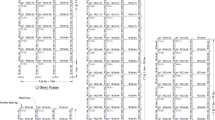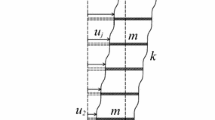Abstract
In order to estimate the seismic demand by using the nonlinear static procedure, different approximate methods have been developed. One of the most useful methods is called displacement coefficient method (DCM), which is based on some modification factors. One of these coefficients denoted C1, concerns the inelastic deformation ratio and usually depends on either the yield-strength reduction factor or the ductility factor. In general the evaluation of the inelastic deformation ratio is based on the response of single degree of freedom (SDOF) systems, where the response of the structure is mainly controlled by the fundamental mode, knowing that the inelastic deformation ratio will not capture the contribution of higher modes in the overall structural response. A developed theoretical approach with the aim of estimating the inelastic deformation ratio for structures, considering contribution of higher modes of vibration, is introduced. In this assessment, the normalized yield strength coefficient (η) and the post-to-preyield stiffness ratio (α) are key factors. The results are compared to the uncoupled modal response history analysis (UMRHA) procedure and some existing formulations for a nine story building subjected to the El Centro 1940 ground motion. It appears that the new theoretical approach leads to enough accurate estimation of the inelastic deformation ratio compared to the UMRHA one.
Similar content being viewed by others
References
FEMA, Building Seismic Safety Council, NEHRP guidelines for the seismic rehabilitation of buildings, FEMA–273, Federal Emergency Management Agency, Washington (DC) (1997).
FEMA, Prestandard, Commentary for the seismic rehabilitation of buildings, FEMA–356, Federal Emergency Management Agency, Washington, DC (2000).
A. S. Veletsos and N. M. Newmark, Effect of Inelastic Behavior on the Response of Simple Systems to Earthquake Motions, Department of Civil Engineering, University of Illinois (1960).
N. M. Newmark and W. J. Hall, Earthquake Spectra and Design, Earthquake Eng, Research Institute, Berkeley, CA (1982).
K. Shimazaki and M. A. Sozen, Seismic Drift of Reinforced Concrete Structures, Hazama–gumi (1984).
X. Qi and J. P. Moehle, Displacement Design Approach for Reinforced Concrete Structures Subjected to Earthquakes, Earthquake Engineering Research Center, College of Engineering/University of California, 91 (2) (1991).
E. Miranda, Seismic Evaluation and Upgrading of Existing Structures, CA, USA: University of California at Berkeley (1991).
E. Miranda, Evaluation of site–dependent inelastic seismic design spectra, Journal of Structural Engineering, 119 (5) (1993) 1319–1338.
W. D. Iwan, Estimating inelastic response spectra from elastic spectra, Earthquake Engineering & Structural Dynamics, 8 (4) (1980) 375–388.
A. Whittaker, M. Constantinou and P. Tsopelas, Displacement estimates for performance–based seismic design, Journal of Structural Engineering, 124 (8) (1998) 905–912.
E. Miranda, Inelastic displacement ratios for structures on firm sites, Journal of Structural Engineering, 126 (10) (2000) 1150–1159.
A. K. Chopra and C. Chiatanapakdee, Inelastic deformation ratios for design and evaluation of structures, Rep. No. EERC–2003–09, EERC, Univ. of California, Berkeley, California (2003).
T. Vidic, P. Fajfar and M. Fischinger, Consistent inelastic design spectra: strength and displacement, Earthquake Engineering & Structural Dynamics, 23 (5) (1994) 507–521.
E. Miranda, Estimation of inelastic deformation demands of SDOF systems, Journal of Structural Engineering, 127 (9) (2001) 1005–1012.
E. Miranda, Evaluation of iterative schemes in equivalent linear methods, Earthquake Spectra (2002).
R.–G. Jorge and E. Miranda, Inelastic displacement ratios for evaluation of existing structures, Earthquake Engineering & Structural Dynamics, 32 (8) (2003) 1237–1258.
A. K. Chopra and C. Chintanapakdee, Inelastic deformation ratios for design and evaluation of structures: Singledegree–of–freedom bilinear systems, Journal of structural engineering, 130 (9) (2004) 1309–1319.
R.–G. Jorge and E. Miranda, Inelastic displacement ratios for design of structures on soft soils sites, Journal of Structural Engineering, 130 (12) (2004) 2051–2061.
R.–G. Jorge and E. Miranda, Inelastic displacement ratios for evaluation of structures built on soft soil sites, Earthquake Engineering & Structural Dynamics, 35 (6) (2006) 679–694.
E. Miranda and R.–G. Jorge, Evaluation of approximate methods to estimate maximum inelastic displacement demands, Earthquake Engineering & Structural Dynamics, 31 (3) (2002) 539–560.
S. S. F. Mehanny and A. S. Ayoub, Variability in inelastic displacement demands: Uncertainty in system parameters versus randomness in ground records, Engineering Structures, 30 (4) (2008) 1002–1013.
G. D. Hatzigeorgiou and D. E. Beskos, Inelastic displacement ratios for SDOF structures subjected to repeated earthquakes, Engineering Structures, 31 (11) (2009) 2744–2755.
C. Málaga–Chuquitaype and A. Y. Elghazouli, Inelastic displacement demands in steel structures and their relationship with earthquake frequency content parameters, Earthquake Engineering & Structural Dynamics, 41 (5) (2012) 831–852.
R.–G. Jorge and E. J. González, Implementation of displacement coefficient method for seismic assessment of buildings built on soft soil sites, Engineering Structures, 59 (2014) 1–12.
M. Dicleli and C. Durucan, Evaluation of displacement coefficient method for seismically retrofitted buildings with various ductility capacities, Earthquake Engineering & Structural Dynamics, 43 (9) (2014) 1285–1306.
C.–H. Zhai et al., Inelastic displacement ratios for design of structures with constant damage performance, Engineering Structures, 52 (2013) 53–63.
S. Akkar and E. Miranda, Improved displacement modification factor to estimate maximum deformations of short period structures, 13th World Conference on Earthquake Engineering (2004).
S. D. Akkar and E. Miranda, Statistical evaluation of approximate methods for estimating maximum deformation demands on existing structures, Journal of Structural Engineering, 131 (1) (2005) 160–172.
S. Akkar and A. Metin, Assessment of improved nonlinear static procedures in FEMA–440, Journal of Structural Engineering, 133 (9) (2007) 1237–1246.
A. K. Chopra and K. G. Rakesh, Direct displacementbased design: use of inelastic vs. elastic design spectra, Earthquake Spectra, 17 (1) (2001) 47–64.
E. Miranda and S. D. Akkar, Dynamic instability of simple structural systems, Journal of Structural Engineering, 129 (12) (2003) 1722–1726.
A. Nassar and H. Krawinkler, Seismic Demands for SDOF and MDOF Systems, John Blume Earthquake Engineering, Ctr. Dept. of Civil Engineering, Rep. 95 (1991).
R. Riddell and N. M. Newmark, Statistical Analysis of The Response of Nonlinear Systems Subjected to Earthquakes, University of Illinois Engineering Experiment Station, College of Engineering, University of Illinois at Urbana–Champaign (1979).
R. Riddell, J. E. Garcia and E. Garces, Ine lastic deformation response of SDOF systems subjected to earthquakes, Earthquake Engineering & Structural Dynamics, 31 (3) (2002) 515–538.
C. Zhai et al., Study on inelastic displacement ratio spectra for near–fault pulse–type ground motions, Earthquake Engineering and Engineering Vibration, 6 (4) (2007) 351–355.
H. Krawinkler and A. A. Nassar, Seismic design based on ductility and cumulative damage demands and capacities, Nonlinear Seismic Analysis and Design of Reinforced Concrete Buildings (1992) 23–39.
FEMA, A. 440, Improvement of Nonlinear Static Seismic Analysis Procedures, FEMA–440, Redwood City (2005).
B. Chikh et al., Seismic structural demands and inelastic deformation ratios: A theoretical approach, Earthquakes and Structures, International Journal, 12 (4) (2017) 397–407.
B. Chikh et al., Seismic structural demands and inelastic deformation ratios: A theoretical approach, Earthquakes and Structures, International Journal, 12 (4) (2017) 397–407.
A. K. Chopra and R. K. Goel, A Modal Pushover Analysis Procedure to Estimate Seismic Demands for Buildings: Theory and Preliminary Evaluation, PEER, Berkely, California, March (2001).
A. K. Chopra and K. G. Rakesh, A modal pushover analysis procedure for estimating seismic demands for buildings, Earthquake Engineering & Structural Dynamics, 31 (3) (2002) 561–582.
T. S. Jan, M. W. Liu and Y. C. Kao, An upper–bound pushover analysis procedure for estimating the seismic demands of high–rise buildings, Engineering Structures, 26 (1) (2004) 117–128.
B. Chikh, Y. Mehani and M. Leblouba, Simplified procedure for seismic demands assessment of structures, Structural Engineering and Mechanics, 59 (3) (2016) 455–473.
C. Benazouz, L. Moussa and Z. Ali, Ductility and inelastic deformation demands of structures, Structural Engineering and Mechanics, 42 (5) (2012) 631–644.
Y.–K. Wen, Method for random vibration of hysteretic systems, Journal of the Engineering Mechanics Division, 102 (2) (1976) 249–263.
A. K. Chopra, Dynamics of Structures: Theory and Applications to Earthquake Engineering, Upper Saddle River, NJ: Pearson/Prentice Hall, 3 (2007).
S. A. Mahin and J. Lin, Construction of inelastic response spectra for single–degree–of–freedom systems, Rep. No. UCB/EERC–83 17 (1983).
Uniform Building Code (UBC), International Conference of Building Materials, 2, Whittier, California (1997) 492.
MathWorks, Inc., MATLAB: The language of technical computing. Desktop tools and development environment, Version 7, MathWorks, 9 (2005).
Author information
Authors and Affiliations
Corresponding author
Additional information
Recommended by Associate Editor Junhong Park
Abdelmounaim Mechaala received his master degree from the Department of Civil Engineering, Civil Engineering, Hydraulics and Architecture Institute of Hadj Lakhde University, Batna, Algeria in 2013. Now he is preparing for a Ph.D. degree in Science and Technology Faculty of Abbes Laghrour University, Khenchela, Algeria. His research interests include earthquake engineering and structural dynamics.
Chikh Benazouz, Ph.D., is an Associate Professor of earthquake engineering at ENSTP (High National School of Built and Ground Works Engineering, Algiers, Algeria) and Senior Researcher at CGS (National Earthquake Engineering Research Center, Algiers, Algeria).
Rights and permissions
About this article
Cite this article
Mechaala, A., Benazouz, C., Zedira, H. et al. Higher modes contribution for estimating the inelastic deformation ratios and seismic demands of structures. J Mech Sci Technol 33, 591–601 (2019). https://doi.org/10.1007/s12206-019-0113-8
Received:
Revised:
Accepted:
Published:
Issue Date:
DOI: https://doi.org/10.1007/s12206-019-0113-8




